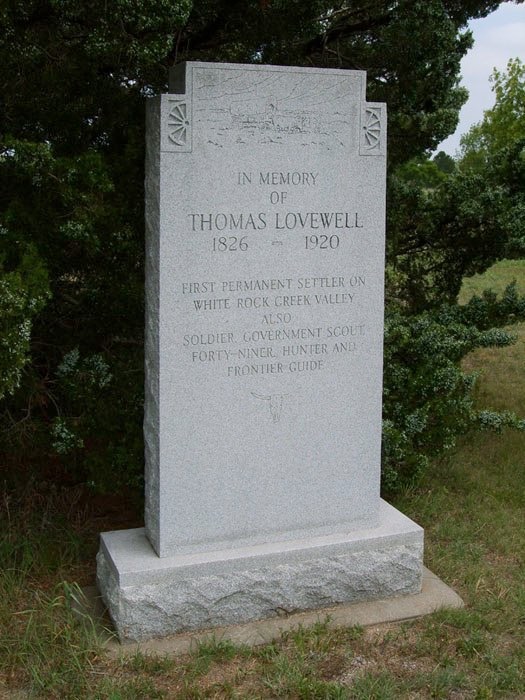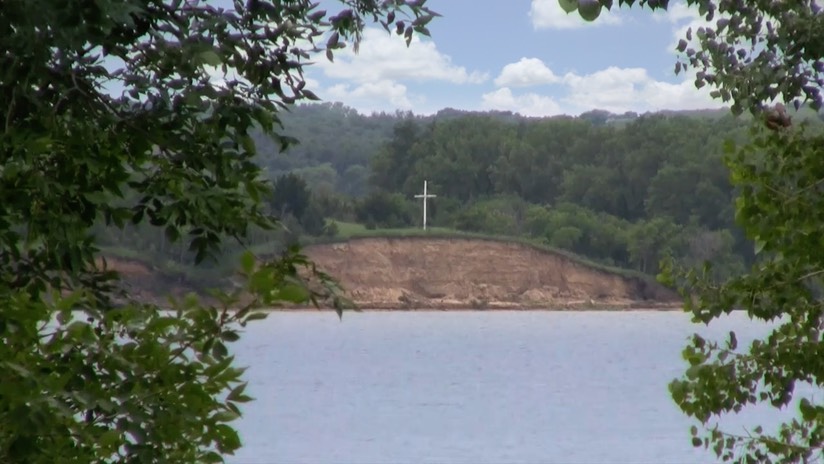My thanks to Tom Robinson for providing the link to a story in the Superior Express about a recent photo scavenger hunt at Lovewell State Park. Although the Express writer was the only person willing to take up the challenge earlier this month, Sandra Foote’s writeup makes a helpful guide to some often-overlooked historical features at the park. The first item on the hunt, the one that might seem the most obvious, is also one I’ve only ever bumped into a single time, back in 2006. Thomas Lovewell’s monument has sat in the same place near the park entrance since the 1960’s, but it must have been more noticeable in years past, before the surrounding pines had filled out enough to provide a bit of camouflage.

Hepsabeth Lovewell’s great-great-granddaughter, Barb Gray, who traveled to Jewell County in 2005 to check on the whereabouts of her ancestral cousins, evidently didn’t catch sight of the monument either. When she emailed me from her home in Escondido to ask what I knew about it, I diligently searched the Internet for a picture, but came up empty. I managed to contain my curiosity for about two weeks before jumping in the car and setting out on a 700-mile road trip.
Not only did I return with a camera stuffed with images of historical treasures that weekend in August of 2006, but I managed to pick up a few more during the Lovewell/Davis reunion the following year. Still, as late as the spring of 2015, I had not yet glimpsed the large white cross which marks the gravesite of massacre victims buried at the summit of a bluff overlooking the south shore of Lovewell Lake. I had heard that the cross is over ten feet tall, but someone still had to tell me where I needed to stand to get a good view. A video clip which I took that morning makes it seem about as inconspicuous as the statue of Christ the Redemer in Rio, unless you understand that my camera lens was zoomed in as tight as it would go, with the image stabilizer switched on and the camera braced firmly, while I held my breath. In short, it’s smaller and father off than it seems in the image on the right.

It’s probably more fun to ramble about and discover things on your own, but without a guide you’ll miss something, and Sandra Foote’s story leads me to guess that I’ve missed quite a lot without knowing it. The news that really got my notice, however, is that the park now has wifi, and Ms. Foote reports that it worked everywhere the scavanger hunt led her.
For those wanting to learn more about Thomas Lovewell, the Express recommends two inexpensive paperbacks which they happen to sell, Roy Alleman’s 1995 “The Bloody Saga of White Rock,” and Ellen Morlan Warren’s “White Rock Historical Sketches,” first published in 1933. My only caveats are that Mr. Alleman’s book is unabashed historical fiction while Ms. Warren’s is based to some extent on vintage neighborhood gossip. However, anyone unwilling to hold out a bit longer for Rhoda Lovewell’s exhaustive updating of family history will find that those two earlier books basically get the job done.
Curious searchers googling Lovewell State Park will eventually run across a publication called “The age and taphonomy of mammoths at Lovewell Reservoir, Jewell County, Kansas, USA” printed in the July 2007 Issue of Quaternary International, and available online, which is exactly as pulse-pounding as it sounds.
Remains of five mammoths have been excavated along the north shore of Lovewell Reservoir on White Rock Creek, Jewell County, Kansas. Two additional mammoths have been recorded as surface finds. These seven mammoths are clustered within a distance of 2 km and are contained within sediments dating to the transition from terminal mid Wisconsin to Last Glacial Maximum. This density of single adult mammoth death sites is uncommon elsewhere on the central Great Plains of North America.
If those few sentences sound lively enough, be warned that they are from the abstract, a distillation of the paper in plain English. This is a dry and scholarly publication, much more concerned with presenting the results of a thorough investigation to fellow scientists than with selling monthly subscriptions to the masses. Yet, I’m sure the contents would prove interesting reading for many, for within these rarified pages is startling evidence that supports very early human habitation in Jewell County. How early? Oh, about 20,000 years ago. Okay, it’s not that startling, but it is interesting. The mammoth bones apparently bear subtle but unmistakable signs of having been worked over by stone hammers.
After a few paragraphs, like me, you may find yourself chanting, “Show us the bones!” There are a few pictures, which look much like of any old rocks with some flecks chipped off them. So don’t go to Lovewell State Park expecting to see full skeletons of woolly mammoths mounted for display in the visitor’s center.
If Quaternary International does decide to go with a glossy monthly magazine, however, I suggest they call it “Single Adult Mammoth.” “Single Adult Mammoth Death Sites” is just too lurid.